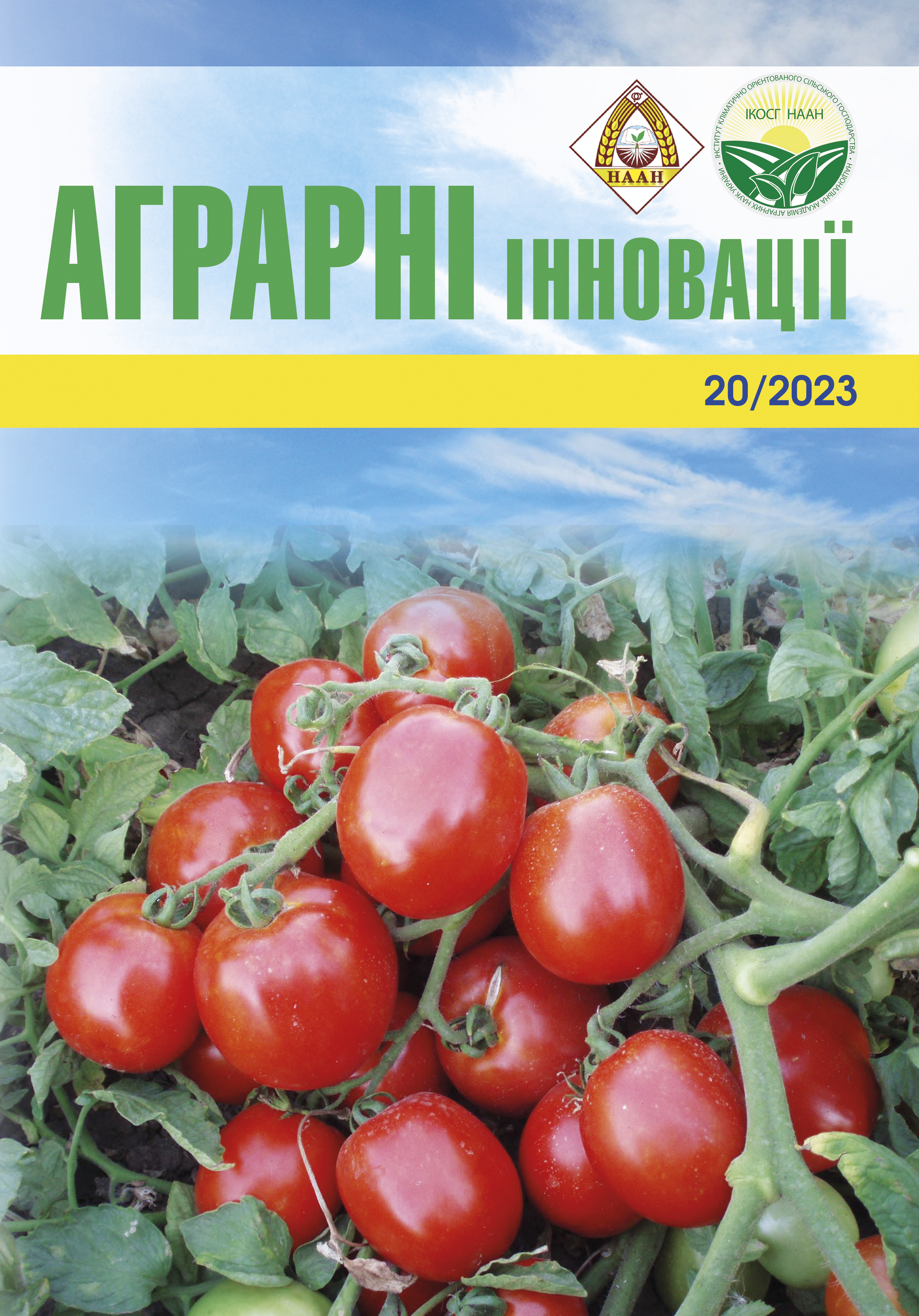Study of soft winter wheat lines from pair crosses of local varieties with GPC-B1 gene donor lines
Abstract
Introduction. At this stage, breeding is faced with a tricky and difficult question of how to increase the protein content of wheat grain without losing yield. As you know, over the past half century, the yield of wheat has increased by 2–2.5 times, but due to the negative correlation between the yield and protein content of the grain, the quality of the grain has been lost in comparison with the ancient extensive varieties. The GPC-B1 gene can become a new stage of breeding for winter wheat grain quality. Taking into account the successful experience of creating varieties in the world with the use of this gene in the world, the selection program for improving the quality of wheat grain with the involvement of the GPC-B1 gene was also started in the wheat selection and seed production department of the SGI-NSNC. Goal. To establish the efficiency of selection for protein content in grain in recombinant lines created from hybridization with donor lines carrying the GPC-B1 gene. Methods. The research was carried out in the research fields of the SGI of the National Academy of Sciences in 2020–2022. Research methods: field, laboratory, statistical. The results. The selection of experimental lines created from paired crosses of local varieties with lines carrying the GPC-B1 gene was carried out. The selection was carried out from the F 3 generation of the breeding nursery (3200 lines) based on morphological characteristics and grain protein content. The selection continued in the preliminary variety test F 4 (296 lines) and variety test F 5 (118 lines) according to indicators of morphological homogeneity, yield, protein, sedimentation level. As a result, we obtained lines from each hybrid population that have a higher level of grain protein and bread-making properties than the parental components, and the yield is on par with the standard. Unfortunately, the frequency of such lines in our studies is not high, and these lines still need to be studied in detail, both in sex and laboratory conditions. Conclusions. The introduction of the GPC-B1 gene into the local gene pool of soft winter wheat by hybridization changes the protein content of the grain. The protein content is significantly suspended under the influence of the GPC-B1 gene. Also, it can have a positive effect on bakery indicators (sedimentation). The number of lines that would meet all the modern requirements of the variety is equal to 1.7–3.4% of the initial one. In this way, the lines pass further in competitive environmental variety tests and on different agro backgrounds as possible candidates for transfer of a new variety to the State variety test.
References
2. Фанін, Я. С., Литвиненко, М. А., & Молодченкова, О. О. Біохіміяний склад та технологічна оцінка зерна інтрогресивних ліній пшениці мякої озимої з генами високої білковості від Triticum Dicoccoides та Aegilops Tauscnii. Publishing House “Baltija Publishing”. 2022. С. 27‒31.
3. Маханьова Ю. М. Експорт зернових культур України, ЄС і країн світу в умовах сучасних інтеграційних процесів. Ю. М. Маханьова. Проблеми економіки. 2015. – №1. – С. 27–36.
4. Рибалка О. І. Сучасні дослідження якості зерна пшениці у світі: генетика, біотехнологія та харчова цінність запасних білків. О. І. Рибалка, Б. В. Моргун, В. М. Починок. Фізіологія і біохімія культурних рослин. 2012. – Т. 44, №1. С. 3‒22.
5. Воропай, Г., Молеща, Н., Поліщук, В. Сучасні тенденції розвитку сільськогосподарського виробництва на осушуваних землях Лівобережного Лісостепу України. Вісник аграрної науки. 2021. 99(5), 50–59.
6. Литвиненко, М. А. 100-year history of the development of bread winter wheat breeding programs. Plant Varieties Studying and Protection. 2016. (2(31), 75–82.
7. Shewry P.R. Improving the protein content and composition of cereal grain. J. Cereal Sci. 2007;46:239-250. DOI 10.1016/j.jcs.2007.06.006.
8. Johnson V.A., Mattern P.J., Peterson C.J., Kuhr S.L. Improvement of wheat protein by traditional breeding and genetic techniques. Cereal Chem. 1985;62(5). Р. 350–355.
9. Balyan H.S., Gupta P.K., Kumar S., Dhariwal R., Jaiswal V., Tyagi S., Agarwal P., Gahlaut V., Kumari S. Genetic improvement of grain protein and other health-related constituents of wheat grain. Plant Breeding. 2013. available at http://wileyonlinelibrary.com. DOI 10.1111/pbr.12047.
10. Avivi, L. High protein content in wild tetraploid Triticum dicoccoides Korn.Proc. 5th Int. Wheat Genet. Symp. Ed. S. Ramanujam. Indian Soc. of Genet. and Plant Breed. New Delhi, India. 1978. P. 372–380.
11. Joppa, L. & Cantrell, R. Chromosomal location of genes for grain protein content of wild tetraploid wheat. Crop Sci.,1990. №30, P. 1059–1064.
12. Distelfeld, A., Cakmak, I., Peleg, Z., Ozturk, L., Yazici, A.M., Budak, H., Saranga, Y.& Fahima, T. Multiple QTL-effects of wheat Gpc-B1 locus on grain protein and micronutrient concentrations. Physiol. Plantarum. 2007. 129. Р. 635–643.
13. Chee, P., Elias, E., Anderson, J. & Kianian, S.. Evaluation of a high grain protein QTL from Triticum turgidum L. var. dicoccoides in an adapted durum wheat background. Crop Sci. 2001. 41. Р. 295–301.
14. Fox S.L., Townley-Smith T.F., Humphreys D.G., McCallum B.D., Fetch T.G., Gaudet D.A., Gilbert J.A., Menzies J.G., Noll J.S., Howes N.K. Somerset hard red spring wheat. 2005. available at http:// www.pgdc.ca/pdfs/wrt/cultivar descriptions/ Somerset.pdf. (дата звернення: 10.06. 2023)
15. Brevis J.C., Dubcovsky J. Effects of the chromosome region including the Gpc-B1 locus on wheat grain and protein yield. Crop Sci. 2010. № 50. Р. 93–104. DOI 10.2135/cropsci2009.02.0057.
16. ДСТУ 4117:2007 Зерно та продукти його переробки. Визначення показників якості методом інфрачервоної спектроскопії. ‒ Держспоживстандарт України. 2007 C. 8.
17. Пат. № 17023 Україна, (2006) А01Н 1/04. Спосіб непрямої оцінки «сили» борошна – седиментація SDS-30. О.І. Рибалка, М.В. Червоніс, М.Г. Парфентьєв, Д.В. Аксельруд; патентообладатель Селекційно-генетичний інститут. – №u200610062; заявл. 06.02.2006; опубл. 15.09.2006; Бюл. №9. С. 6.
18. Методика державного сортовипробування сільськогосподарських культур. Зернові, круп’яні та зерно-бобові. Київ, 2001. С. 66.






